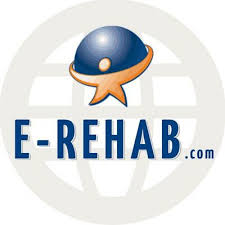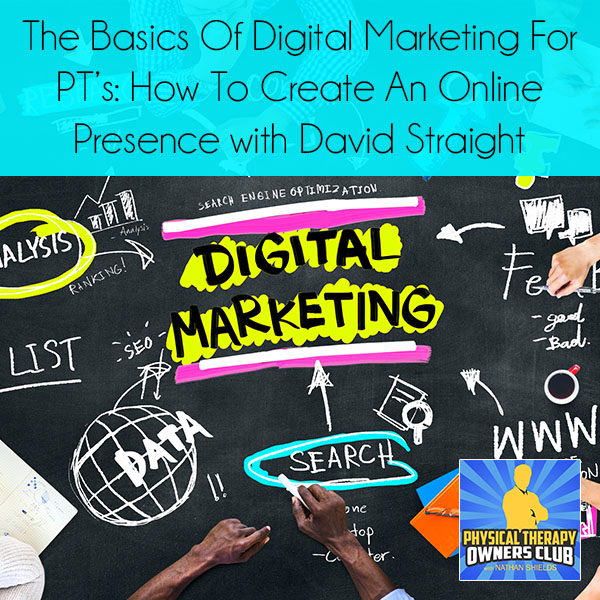
—
Listen to the podcast here:
The Basics Of Digital Marketing for PT’s: How To Create An Online Presence with David Straight
 My guest is David Straight. He’s a physical therapist and Co-Owner of E-Rehab.com, a digital marketing company. To tell you a little bit about David, he’s a fellowship trained Doctor of Physical Therapy and has treated patients for over fifteen years. He’s also an author, a speaker, a marketing expert, the marketing director of a seven-location private practice and the co-owner of E-Rehab.com. David and his business partner own and operate a digital marketing agency that serves the physical therapy private practice market. He and his company provide custom websites, high-value email marketing, local SEO, reputation marketing and not just management, affordable video marketing, and consistent social media marketing for over 1,600 locations across North America. He’s the author of a book called Booked Solid: The Fast, Easy and Affordable Way to Use the Internet to Drive more Patients in the Door, and he’s coming out with his second edition soon.
My guest is David Straight. He’s a physical therapist and Co-Owner of E-Rehab.com, a digital marketing company. To tell you a little bit about David, he’s a fellowship trained Doctor of Physical Therapy and has treated patients for over fifteen years. He’s also an author, a speaker, a marketing expert, the marketing director of a seven-location private practice and the co-owner of E-Rehab.com. David and his business partner own and operate a digital marketing agency that serves the physical therapy private practice market. He and his company provide custom websites, high-value email marketing, local SEO, reputation marketing and not just management, affordable video marketing, and consistent social media marketing for over 1,600 locations across North America. He’s the author of a book called Booked Solid: The Fast, Easy and Affordable Way to Use the Internet to Drive more Patients in the Door, and he’s coming out with his second edition soon.
He has presented at multiple national, state and local professional conferences as well. His passion is to help people understand that physical therapy is the best first choice for neuro-musculoskeletal conditions. I broke David’s interview into two parts because we talked a lot about digital marketing on the front end but also slid into creating a generalized marketing strategy that incorporates not only digital marketing but also reminds us not to neglect that physician relationship that we have with our community physicians. I broke this up into that second part to cover that part of it, but in this one, we talked specifically about the best practices and some of the basics of digital marketing. One thing I want you to find out is he shares a secret as to the number of online reviews are needed to influence a customer’s decision and make an online impact to choose you.
The second thing is he talks about how there are three parts to marketing. There’s number one, ensuring that you have clinical excellence, number two, excellent customer service and number three, building the reputation in your community. Now you can have number one and number two and things are going great, but that’s not going to ensure the success of your business unless you have number three, building that reputation that sets you apart from the hospital networks and the physician on practices. You have to promote your customer service and your clinical excellence in order to set yourselves apart and compete against those others and if you’re not, you’re trending in the wrong direction. I hope you enjoy part one and part two. You’ll see that I ended regretfully here in the middle of our interview. Nonetheless, look out for part two as well where we cover some more interesting topics. I hope you get a lot of it.
—
Thanks for joining me, David. I appreciate you taking the time coming in and talking to us a little bit about our online marketing presence and how important it is. Do you mind sharing your story and where you came from and what got you to where you are?

Thanks, Nathan, for having me on and the opportunity to speak with you about some of these issues and opportunities that private practices are facing and can take advantage of. My story is such a classic. If anybody has ever read the E-Myth by Michael Gerber, I was a physical therapist at a POPS clinic, but I didn’t know what the POPS was. I decided to go to PT school and it was after going through some registry physical therapy that I realized I wanted to have my own business. I thought there was a good opportunity to do a better job of it. After a couple of years of doing that, I worked at a hospital for two years. I opened up private practice, but I didn’t have any idea what I was doing. I didn’t understand business whatsoever. I ended up failing. It depends on how you define failure.
What do you mean by fail? What happened?
I was working too many hours. I did make money, but I was working too many hours. I ended up partnering with a gentleman by the name of Paul Gaspar and then from there, we grew our clinics. All along I always enjoyed using the internet. One of the things that I held at the forefront of my treatment approach was education. The internet’s all about education information. I thought it’s a wonderful tool. I created an online exercise program in 1999 where you could program in. We had these little animated GIFs and stuff. It was well received.
What happened to us is we lost 49% of our business to physician-owned clinics within six months. We went from treating the doctors, the doctors’ wives and families, the most powerful people in the community to, “You don’t know what you’re doing and your physical therapy sucks.” Literally, one month we were on the schedule to author a chapter for an orthopedist that was writing a book on orthopedic medicine. We’re going to author the rehab section. We wrote the protocols for ProDisc rehabilitation. The next month when the money mattered more than anything else, loyal patients came back to us and said, “The doctor’s saying that you’re no good and that you don’t know what you’re doing.” We’re in a panic but we have to learn how to market really quick and more than marketing, selling, we need seller services.
I always enjoyed the internet. I built websites for our practices since the mid-‘90s. It wasn’t more of just education and information, it was about marketing and selling. That’s my backstory and then around 2003, I realized that none of our other colleagues had a good online presence and needed help in that area. That’s when I started in E-Rehab. We’re building websites, we were the first company to do it for a physical therapy private practice. It’s always fun that as your business goes through these phases, some leaders in the industry that were well-respected, we reached out to them and said, “What do you think about this and how can we do a better job?” They thought we were going to fail miserably, because what referral business needs a website or a newsletter?
They didn’t see the trends coming. You had a little bit ahead in the sand there.
I would say part of it was just good luck, but also having a passion for private practice and also identifying a need. I found an awesome partner, a wonderful guy. He has been my partner ever since and he’s the technical side of things and so my job is to help find people that we can serve. His job is to build the systems and stuff. It’s been a great ride and we’ve enjoyed it and to this day I still have a ton of passion for it. That’s our story.
You’ve mentioned E-Myth and E-Myth Revisited. Is that a book that you used back then when you’re going through your trials and even now with your business?
I read that book back in the early 2000 and then I went and took a course with Michael Gerber. A lot of his stuff resonated with me and it was the situation that a lot of small business owners go through. You want to McDonaldize your practice. It’s the way he presented the stories he told.
It’s nothing specific to PT. It’s the responsibility or the bane of our existence as small business owners that we have to learn how to set up policy or procedures and systems and that’s what gets us over the hump.
The market is so competitive now. Marketing isn’t optional anymore; it’s a necessity. Click To TweetThat goes for marketing too. I would say that a lot of specialists and professionals, a good percentage of them resent marketing. The idea is they spend all this time and this money and they learned to provide a valuable service, whether it be a CPA, endodontists or physical therapists. They expect when they graduate that patients are going to come to them. In physical therapy, the market is so competitive now, that isn’t the case. They don’t realize. As we were speaking about, physician referrals are decreasing. There’s a PT now on every corner it seems like. Marketing isn’t optional anymore and in fact, it’s a necessity. There are plenty of opportunities still because there’s such a great demand for our services, but you have to learn how to do good business. They credit to you for creating this information resource for people so that they can learn more about how to run a business.
That’s the important thing I want to share with people in bringing on guests like you who provide this service for physical therapist specifically. A lot of times, as the business owners, we feel like we have to do everything and thus, we have to know everything. When we do that, we become average or mediocre or worse and add everything and not focus on what we are experts at specifically. There’s 90% of the population out there that hasn’t used physical therapy or isn’t being referred to physical therapy. Now that physician referrals are declining, we have to learn how to get ourselves out there digitally in the ways in which we can hit directly to the consumer and that’s important. When you’re talking to the guy who’s seeing a full-time load of patients or even a part-time load of patients and trying to run his business at the same time, trying to get a digital marketing presence out there can be difficult if they try to do it themselves. Having a company like you that can help with that is extremely beneficial.
I would agree with that for sure. I think about all of the responsibilities and it reminds me of a quote from Richard Branson when he said, “Most business owners will become more successful or can get to the next level if they end up doing less, not doing more.” Physical therapist goes through different stages through the life cycle of their business. One of the stages you have to go through is first, you’ve got to get people in the door and in order to do that nowadays, you’ve got to have a great online presence. When I was in business, I went through a bunch of the courses online and offline and the different companies that provided those. At the end of the day, I was highly motivated when I got back, but I didn’t have any more time.
It became, to a great degree, a waste of my time and money to do those things. I didn’t realize, “I can be smart but if I don’t execute, it doesn’t matter.” When my creativity rehab from those experiences, I wanted to be a service business where I can essentially teach them why they needed the tools, but more importantly, deliver the tools and services for them because they didn’t have time to do it. We think about when I consult with people to find out if they’re a good fit for our services, we only work with small practice owners. The first thing I talk about is marketing. We talk strategy. What is marketing? We define marketing as getting someone who has a need for physical therapy to know, like and trust you.
If there’s somebody in your community that needs physical therapy and they know, like and trust you, there’s a high likelihood they’re going to try you out. That is a simple definition of marketing, not mine, it’s John Jantsch’s Duct Tape Marketing definition. That’s something that everybody seems to understand. We want to make sure that they understand as well that online marketing is tactical and you have to look at the bigger picture and have a marketing strategy. What you want to do is identify who you are and who your ideal target audience is. What your message is, what your platform is, and then from there, you can implement tactics to disseminate that message. That comes from for example, a total online presence. There are other aspects of a complete marketing strategy that would include things like advertising.
Many people think of advertising as what marketing is like a newspaper ad, Google Adwords, Facebook advertising, radio, television, magazines, but that’s only a tiny part of marketing. There’s also the PR part of things and then of course, you need to have a referral marketing strategy. To develop that marketing plan out more, you have to be able to measure the outcome of your efforts and then you have to define a calendar. The cornerstone of marketing is repetition. That’s a challenge for a small business, for the chief cook and bottle washer to try to do all those things. There’s a lot there and most of them don’t do it. They jump right through to, “I need a business card, I need a referral pad and I need a website.”
Clinical excellence and great customer service mean nothing if you don't promote and build a reputation. Those three things, working together, will set you apart to succeed. Click To TweetWhat we provide are things that we feel in almost all cases would be necessary tactical tools to do a good job of marketing to your community. The other way that we sell it that I love to share with people is you’ve heard of funnels. Most people have heard of funnels, but we don’t think of it that way. We think of it as two funnels. When you put the one on top of the other and you flip one upside down, it looks like an hourglass. We call it a marketing hourglass and the relationship that all of your patients go through is they know, like and trust you. They buy, they repeat, and you hope you can get them to repeat and refer. The buy, repeat and refer at the bottom of the hourglass. The reason we define it that way is that we want to make sure there is adequate emphasis on the buy, repeat, and refer.
Most marketing funnels, it’s all about lead generation, lead conversion, nurturing and sale. We think of it in a broader sense and then we talk about how you can use digital tactics to optimize all of those steps in the patient life cycle. The other thing that we utilized way back when we started was a term that was very rarely used, patient relationship management. Each one of those steps is an opportunity for you to enhance that relationship, develop new relationships, nurture those relationships, and get people in. Those are the ways that we like to describe how we can apply these tactics and then, therefore, get more people into the business.
Some of your clients are successful physical therapists. What are they doing to make sure they cover all those bases? You listed a bunch of them and I know most PTs won’t have the time and some of them may not have the energy to do all that stuff. What do you recommend that most successful PTs do?
The most successful ones, they realize they have received a business education. They’ve got the business education so they understand that their business goes through different phases. In any business life cycle, it goes through different phases. That’s important to understand that during different phases of your business development, there are different things you need to do. One of the core things that we discuss often is we like to use data to drive our decisions. We don’t like to use whatever the latest and greatest bright and shiny object or silver bullet is. You don’t gravitate towards that. We don’t provide a Twitter strategy. We don’t provide a Snapchat strategy. This is not about Instagram, even though it’s a rapidly growing network. These things are not a way that consumers get to physical therapy. Now, I’m saying mostly. If we looked at the bell curve of the vast majority, don’t use Instagram.

In fact, Google did a good presentation where they shared that 99% of consumers use anything but a social network to find information or to find out about a particular service or a particular provider. They use Google. Then they use specialty websites like WebMD and Mayo Clinic or Harvard. They use Wikis to look up definitions and stuff, and then only a small percentage ever look on social media. I ask people, “When’s the last time you looked up your plumber, your locksmith, your physical therapist, your endodontist or your cardiologist on Facebook when you have that immediate need the first time?” Everybody says, “I never did.”
They’re going to go straight to Google.
You’ll get a referral or find out from friends, family members, word of mouth, those are the things. While those social media strategies are important, we provide some of those things. When you’re starting off and when you’re a small practice, it shouldn’t be your top priority. It’s thinking about who your market is, the people that you’re going to see and the media you’re going to use, how are you going to disseminate your message, and then what exactly that message is going to be.
We talk about having a great website. Make sure that you rank well on the search engines. Make sure that when we think about know, like and trust, you’re getting ranked on the search engines helps people to know you. Having a great website, making great presentations, people judge what they can’t see based on what they can see. In fact, I was talking to some people that are putting together a network and the way they were judging whether or not they should contact somebody was based on how their website looks, which I thought was very curious. After that, how do you get people to trust you?
That’s where we say build your reputation, and that’s a lead conversion strategy. You’re not going to have more people learn about you because you have a great reputation. That’s going to help people make the decision as to whether they should choose you. Somebody might refer because you have a great reputation, but the first time somebody gets to know you, word of mouth or online, there’s a lot of referrals, it’s ranking on Google or having somebody verbalize your brand name, your practice name, and then after that, they might go to your website. A majority of people go to Google. Google’s the home page for a majority of people that visit the website. That’s where you want to present your reputation.
The internet is all about education and information. Click To TweetDo you find that reviews and testimonials do quite a bit for not only putting you up there but also increase your SEO?
There are seven major factors that have been identified in our SEO profession. Ratings and reviews are certainly something you can’t control, but if it was the only factor that mattered with search rankings, number one, you’d always see somebody with the highest reputation ranking number one. More importantly, Google knows this and everybody was trying to game the system. There are over 200 factors that are taken out by the algorithm when they decide who ranks where. Nevertheless, reputation is a multiplier because it helps you rank higher and also for all those people that are seeing your business on Google and your website. Having a great reputation helps convert people. I’ve had people that it saved their business, believe it or not.
We had people that were surrounded by narrow networks hospital-based systems and POPS and were dying and we got them ranked. We built their reputation and then all of a sudden, it has revitalized them. Sadly enough, small practice owners, especially if they’re just starting, they don’t understand that 90%, it’s 80% something, I don’t remember the exact number but after they’re referred, will go look you up online. If you have no web presence or a very poor web presence, then it’s a reflection of the type of business you do. That’s the way people think and may be the case.
You have to recognize that it’s so competitive. There are PTs are all over the place and now you’re not just going up against other physical therapy owners that might be just as busy as you are. You’re going up against hospital networks and physicians, physical therapy practice that do have a budget for this stuff. You’ve got to be able to get up to par.
That’s a great point. We live in ratings nowadays, even ten years ago. Back in the late ‘90s is when Amazon started its ratings and reviews system. Back there, they’re always way ahead of the times and then Google came around and Yelp developed the business model for Yelp, ratings and reviews. Since about 2008, we were trying to help people get ratings and reviews because we had this notion that in a review society, people don’t just look at your name anymore and they don’t trust word of mouth completely anymore. If they don’t have word of mouth but they think they need a service, but they’re not sure who to go to, especially the Millennial generation, 96% of those people trust ratings and reviews as much as they do a word of mouth referral.
For years, we tried to help people get ratings and reviews and we failed. When we finally figured out a system to help people get ratings and reviews because such a high percentage people are looking at these things, it certainly can make a difference when you’re competing against hospitals and POPS. As to your point exactly, how do you compete against ATI or these big select therapy when they have whole departments and staff members in six and seven-figure budgets nationally for the market. How do you compete? Curiously enough, one of the ways you can absolutely compete and differentiate yourself, which is what we’re always looking for, is through reputation. In my experience, there are only a couple of things small practices can differentiate on and it’s customer service and clinical excellence. If you do those things well and you disseminate that information through the conduit that people are using to decide whether or not they should go to you, therefore, reputation ratings and reviews, you can create a distinct competitive advantage.
One of the great tests that I like to execute with people is who else has a great reputation in your market will find in physical therapy still to this day? Very few people in a lot of markets have implemented it as part of their culture and therefore have an understanding of the value of ongoing ratings and reviews. That’s what we try to help them understand and if they follow through with it, it has so many side benefits to it. When you build a great reputation somewhere past 35 to 40 reviews, people start to verbalize, “I checked you out and I saw that you had a great reputation, so I chose you.”
Business owners will become more successful if they end up doing less, not doing more. Click To TweetNot only when you have a great reputation does it get more people in the door, but it’s a great way for your therapist and your staff to get feedback about the fact that they do a great job. When you’re a small practice, you don’t have a lot of peers out there and you wonder. When I first started, I always wondered, “Why didn’t the patient come back? Did I do something wrong? What happened?” I studied that across our practice and found that there was a myriad of reasons why people don’t come back and in most cases, it had nothing to do with me. When you get ratings and reviews and you get that great feedback. It’s positive reinforcement in a profession that can be a burnout profession.
You’re always getting positive accolades back, that helps reinforce your company’s culture and that you’re doing a great job and the people are benefiting from your service. The other things we find that it helps with ratings and reviews is when people get to the stage where they want to grow and one of the main ways you grow is to hire people to do the work for you. PTs want to work for practices that have great reputations. When you build a great reputation online, which given there are so many choices now because there are so many key practices, how does a potential employee differentiate things? If I’m a developing therapist, I want to work in an environment that’s a great environment and reputation is a reflection of that.

I’d never made the connection that possibly the ratings and reviews that you have on Google could be a great recruiting tool. You and I both know that if we’re considering going with a company, physical therapy or not, but if we’re thinking about this possibly being a future employer for me, I’m going to go check out their website. I’m going to see how active it is and see if there are reviews and testimonials. Going back in that, if you are clinically excellent and you provide great customer service, but you’re not getting that out to the public, especially digitally, then it’s useless. You’ve got to promote what you’re doing and that’s how you can set yourself apart.
Gary Vee, he made the famous statement a few years ago that all businesses are media businesses now. There’s some truth to that. People tend to extrapolate statements from influencers don’t necessarily apply, but you certainly can have an opportunity to use digital media to influence people in your community. If they’re considering you or maybe even help you push out a lot of it, maybe even choose you when they’re not thinking about it. You’ve got to have a marketing strategy in place.
What are PTs budgeting for their digital online presence and for their marketing strategies?
I get that question a ton and now as we’re speaking before, there’s good data and reports out there that say that about half of PT practices have no budget at all. They haven’t even planned for it at all and everybody’s looking for a number. My answer is a little bit different. My answer is it depends on the stage your business is in as to how much you would budget. It also depends on what your business plan is. Curiously enough, some practices are happy where they’re at and that’s okay. If you are just starting off, then you’re going to have more time than money and so you’re going to do more guerrilla-type marketing where you’re building relationships and you need some basic tools while you’re doing that.
At the same time, you’ve got to have a consistent budget because you can’t do all the work yourself. You can’t treat patients and grow your practice when you’re starting. You’ve got to have a decent budget. I actually wrote a book on this. The key that has resonated with the people I’ve spoken with is once they realize that they’re profitable or they’ve reached breakeven and then they have empty scheduled spots on their schedule they’re not utilizing, it’s all about booking your practice solid. Once you breakeven that every slot that you’re not billing is lost profit. You’re still going to pay your staff and you’re still going to pay your rent, which are your two biggest cost centers and there are tons. There are small variable costs, not too many. Once you go past breakeven, you start to become profitable. Then the key is not to say, “Now I put all the money in my pocket.” That’s a little bit shortsighted. The idea is to start stepping on the gas and then trying to book your practice solids. What is in your practice? What’s the maximum capacity that you work at?
All businesses are media businesses now. Click To TweetOurs is based on the size of the clinic. I know that works in a lot of situations. If it’s a 3,000 square foot clinic, then we would expect our maximum capacity would be about 80% to 90% of 10% of that. 300 visits a week and the 80%, 90% of that. With a 3,000 square foot clinic, you’d expect to get max capacity up to 250 visits a week, 270 visits a week.
Then somewhere along the line as you’re collecting the revenue for that, you reach your breakeven and then you have to empty time slots. That’s where you want to take some of that profit and of course, put it in your pocket. That is the function of why you opened the business in the first place, but then put more of that money back into marketing so that you can fill every slot on your schedule and get to as close to maximum capacity as you can. Your business will be maximally profitable and then you face a curious new decision in your business, “I need to scale.”
The challenge then is now you’re in a different stage of your business. You need more room and you need more staff and you have to adjust your budget there. This is where having a marketing plan and a business plan is critical rather than just, “I need social media, I need search rankings or I need to do a newsletter.” These are just tactics. Many of the clients, small practice owners that I work with, they go from one silver bullet to the other and they waste a lot of time and money. They never understand their business and they never understand a marketing strategy and budgeting. Budgeting depends on where they are in the life cycle of their business. There are times when you keep and you save and there are other times where you have to wrap more money to get the next. That’s right, ramp it up, you get to the next stage. That’s a long-winded explanation of how I explain what somebody should do when it comes to deciding once they’re going to budget.
How much time are the more successful PTs setting aside for staying on top of their marketing efforts on a week to week basis? I know initially a lot of effort’s going to be put in strategizing and putting together that plan. I’m sure you work with the physical therapists in that regard, but then going forward, how much time would you recommend they set aside each week for marketing specifically?
It depends on what their strategies are. If it’s online marketing, you have to have ways to track your efforts. It depends on your budget. If you’re talking about the foundational strategies that we provide where somebody might be paying $500 a month, I tell them to spend very little time on monitoring that. The time that you spend to try to figure out what you’re monetizing from that investment is more expensive than trying not do it at all. When you get to the four digits a month or five digits a month, you’re spending, then you have to have key performance indicators. KPI is the term that we all use, that’s to what’s working. With our services, we help you get a website and email marketing campaign, rank on the search engines, build a reputation, do video and social media for $500. Whether it’s us or any other people out there, you just do it. You can trust that you’re going to get half a patient a month. It’s almost impossible for that not to happen.
When you’re spending $4,000 or $5,000 a month, then you need to have ways through tracking phone numbers and other indicators to know how many people you’re converting. In most cases, another mistake people make is they think it’s an all or none situation. They’re going to spend $4,000 and they’re going to get nothing and wasted $4,000. You spend $40,000 in marketing, chances are good that you’re going to get something out of it, but then it becomes a question of opportunity costs, which is a fancy way of saying, “Can I get more out of my investment by doing something else rather than spending $4,000 here?”

Look at your conversions because that way you can ask yourself the question, “Should I still be spending the money with online advertising or maybe I need to shift that to try to get a better return?” Those are the times when you need help and a lot of practices are hiring people to help them in that capacity. Unfortunately, a lot of people, this is not necessarily a knock on those people, but they can’t afford to hire somebody who has a business background and a true marketing experience or education. They ended up hiring somebody that is an expert in sales, not marketing, somebody who can disseminate information and usually somebody that can push buttons. A lot of practice owner say, “I just don’t know how to do social media.” They hire somebody that knows how to push the buttons. They abdicate the responsibility to them but that person has no idea about business or marketing strategy. They know how to implement tactics.
They end up spinning their wheels there, “I have got an awesome Instagram strategy. I’m pumping out all kinds of YouTube videos about how to do stretches and exercises.” A sidelight to me, that always bothers me. It’s like, “Why are you showing what people could be doing with exercise? That’s what personal trainers do. Why not discuss how you can help people with particular diagnoses?” That’s more if you have a true marketing background and business plan, that’s the strategy part. If you hire for $15 to $20 an hour, oftentimes they don’t have that skillset. If they find that diamond in the rough, then they’re off and running. They’re going to take you in the direction that’s best for them and not necessarily what’s best for your practice.
Your marketing strategy begins with identifying who you are, who your ideal target audience is, and what your message and platform is. Click To TweetYou see that a lot with Ad words. People pay a lot of money for Google Ad words and they’ll search for physical therapy in Phoenix, Arizona. I see their ad in San Diego and it’s like, that just showed up as somebody that you would think is looking for your practice, but I’m searching from Carlsbad, California. Why is your ad showing in Carlsbad, California? It’s because it’s in the best interest for the people that are selling your ads to show you that there’s lots of activity, but it’s not in the best interests of the practice that’s advertising to somebody in Carlsbad. That’s because you have to understand, you’ve got to be the captain of your ship. Abdicating that completely. In our business, we’d like to compliment them and understand things.
We had to break up this interview into two separate parts because David has a ton to share. We’ll wrap up here with the basics to digital marketing and then look forward for the next episode, the continuation of my interview with David Straight, where we talk about developing your marketing strategy not only online, but also reminding you that improving physician relationships is vital to also increase your new patient arrivals and he shares some techniques in what you can do that. I look forward to next week’s episode and we’ll see you then.
Important Links:
- E-Rehab.com
- Booked Solid: The Fast, Easy and Affordable Way to Use the Internet to Drive more Patients in the Door
- E-Myth
- E-Myth Revisited
- Duct Tape Marketing
- https://EMyth.com
- https://www.DuctTapeMarketing.com
About David Straight

David Straight is a fellowship-trained doctor of physical therapy, has treated patients for over 15 years, as well as an author, speaker, marketing expert, marketing director of a 7 location private practice, and co-owner of E-rehab.com. David and his business partner own and operate a digital marketing agency that serves the physical therapy private practice market. He and his company provide custom websites, high-value email marketing, local SEO, reputation marketing (not just management), affordable video marketing and consistent social media marketing for over 1600 locations across North America. He’s the author of Booked Solid: The Fast, Easy, & Affordable Way to Use the Internet to Drive More Patients in the Door. He has presented multiple national, state, and local professional conferences as well. His passion is to help people understand that physical therapy is the best first choice for neuromusculoskeletal conditions.
